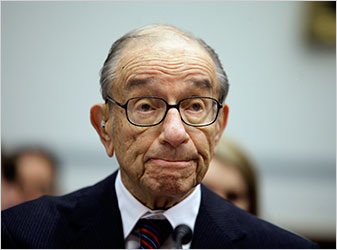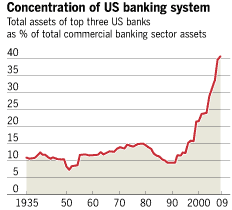
Alan Greenspan has come in for some pretty harsh criticism in the past couple of years about the role he played in inflating the bubble that led to the global financial crisis of 2008.
There are two serious charges against Greenspan. The first is the claim that the Fed ran an excessively loose monetary policy for too long following the 2001 recession, helping to over-inflate asset prices. The second is that he actively blocked efforts to regulate the financial sector and crack down on irresponsible lending.
Regarding the first of these charges, as chairman of the Fed, Greenspan stubbornly clung to the view that financial bubbles cannot be identified in advance; therefore, the theory goes, central banks have no business “leaning against the wind” even in times of very rapid appreciation in asset prices. Instead, central banks should wait and cut rates aggressively to support the economy and financial markets if and when such bubbles burst.
Naturally this sent a strong message to bankers that the risks they faced were asymmetrical: the Fed would not stand in the way of market booms, but it would bail out the bankers if things got out of hand. This expectation became known as the “Greenspan put”.
As the ex IMF chief economist Rajan Raghuram put it in his book Fault Lines:
With the benefit of hindsight, it appears that the Federal Reserve made two mistakes. First, the jobless recovery from the recession of 2001 induced the Fed to keep interest rates extremely low for a sustained period. A lot of excesses were building up, in the rest of the world as well as in the United States…
Second, the Fed actively encouraged the financial markets to believe it would follow an asymmetric policy: it would not lean against a potential unsustainable rise in asset prices, but it would remain ready to pick up the pieces if a bubble burst.
Now, at the same time as the Fed was helping inflate a major bubble in housing, Greenspan was doing his best to prevent any kind of regulation that could have at least dampened the irrational exuberance. Greenspan scuttled efforts to regulate the derivatives market in the late 1990s, and ignored repeated warnings from as early as 2000 to use the Fed’s regulatory powers to crack down on irresponsible subprime lending.
Now, you would think the biggest financial crisis since the Great Depression might have led Greenspan to rethink his extreme ideological view that free markets without regulation always produce the best results.
But apparently not.
In the April edition of International Finance, Greenspan offers a bizarre revisionist take of the financial crisis that makes no mention at all of his own culpability. Instead, everything is the fault of government “activism” — a term he uses 34 times in the paper.
In Greenspan’s view, the crisis was an unavoidable historical accident that has been made worse by the government’s intervention. If only we stopped trying to re-regulate the poor bankers and let them do God’s work, the equity markets can keep sailing to the moon and everything will be OK, he says.
The US recovery from the 2008 financial and economic crisis has been disappointingly tepid. What is most notable in sifting through the variables that might conceivably account for the lacklustre rebound in GDP growth and the persistence of high unemployment is the unusually low level of corporate illiquid long-term fixed asset investment.
As a share of corporate liquid cash flow, it is at its lowest level since 1940. This contrasts starkly with the robust recovery in the markets for liquid corporate securities. What, then, accounts for this exceptionally elevated level of illiquidity aversion? I break down the broad potential sources, and analyse them with standard regression techniques. I infer that a minimum of half and possibly as much as three-fourths of the effect can be explained by the shock of vastly greater uncertainties embedded in the competitive, regulatory and financial environments faced by businesses since the collapse of Lehman Brothers, deriving from the surge in government activism …
I conclude that the current government activism is hampering what should be a broad- based robust economic recovery, driven in significant part by the positive wealth effect of a buoyant U.S. and global stock market.
So in Greenspan’s fantasy land, corporations have stopped investing — not because the economy is undergoing a painful deleveraging process after an unsustainable binge on private debt — but because they are being scared away by “government activism”.
In a high-wire act of logical contortionism, Greenspan also concedes that the US banking sector has grown oversized, generating huge problems of moral hazard. But he then argues that any government action to address this problem is unwarranted, since it could stifle “financial innovation.” You know, innovations that have helped kiddies all over the world, like subprime mortgages, interest-only loans and CDOs.
The emergence in recent years of ever larger American banks, presumed to be protected from bankruptcy by the US government, has fostered market- supplied subsidized cost of capital–a form of activist intervention that has allowed them to expand far beyond where economic analysis has recognized economies of scale …
So the banks have become too big. On this point Greenspan is right. See the chart below from the Financial Times, which shows a massive increase in the concentration of the US banking sector since the 1990s.

But Greenspan then argues:
The degree of complexity and interconnectedness of the global 21st century financial system, even in its current partially disabled form, is doubtless far greater than the implied model of financial cause and effect suggested by the current wave of re-regulation. There will, as a consequence, be many unforeseen market disruptions engendered by the new rules.
Most important will be the reaction of the private non-financial sectors of the US economy to financial reregulation, which is bound to reduce the scope and value of financial intermediation.
Yes, Mr Greenspan, any type of regulation can have unintended consequences. But it is TOO MUCH financial innovation that got us into the crisis.
If regulating the derivatives markets, capping the leverage of investment banks and asking banks to hold more capital as a buffer against future crises happen to shrink the size of the financial sector and slow down “financial innovation”, so be it.
We’ll all be better off.
Just like we’d all be better off if Alan Greenspan stopped trying to revise history and faded away into obscurity.